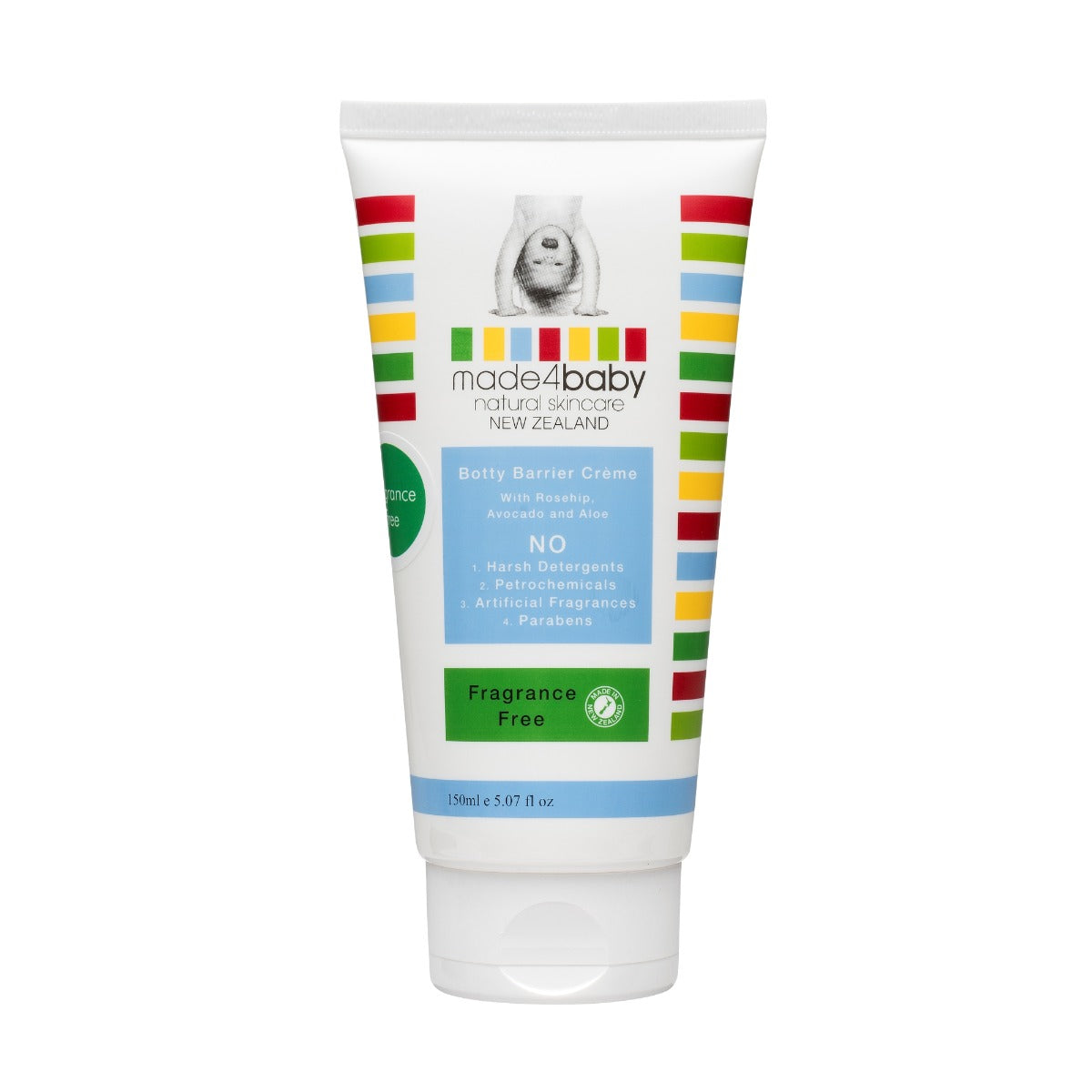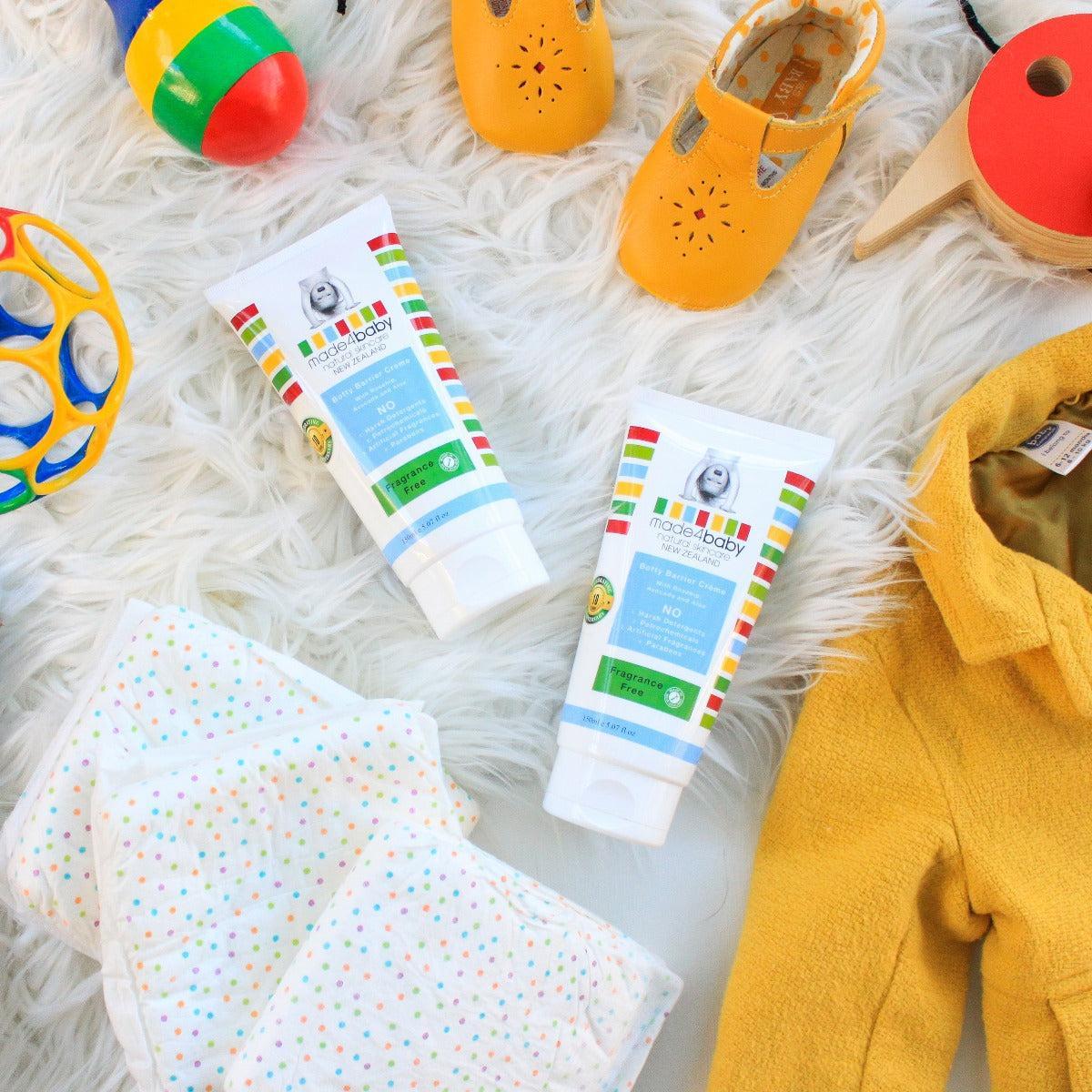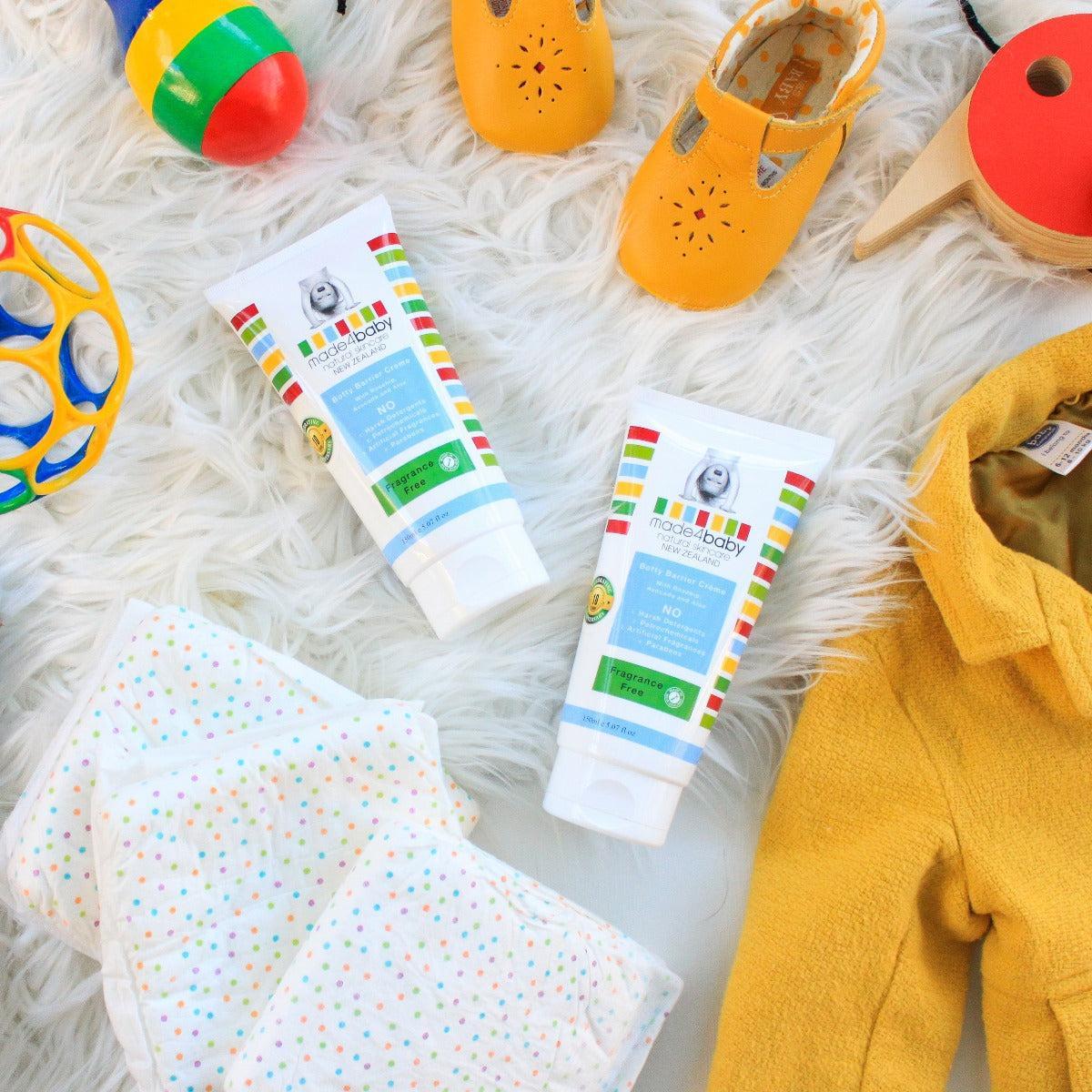Botty Barrier Cream 150ml
Botty Barrier Cream 150ml
SKU:CREMEFF150
Clothing Prem to 18 Months
| Size | Age Guide | Weight | Height |
|---|---|---|---|
| Premature | Premature or Small Newborn | Up to 4Kg | Up to 55cm |
| Newborn | 0-3 months | 4-6Kg | Up to 62cm |
| 3 Month | 3-6 months | 6-8Kg | Up to 68cm |
| 6 Month | 6-12 Month | 8-10Kg | Up to 76cm |
| 12 Month | 12-18 Month | 10-12Kg | Up to 84cm |
| 18 Month | 18-24 Month | 12-14Kg | Up to 92cm |
Clothing 2 to 6 Years
| Size | Age Guide | Height | Chest | Waist | Hip |
|---|---|---|---|---|---|
| 2 Year | 2-3 Years | Up to 100 cm | 56 | 51 | 58 |
| 3 Year | 3-4 Years | Up to 105 cm | 58 | 53 | 60 |
| 4 Year | 4-5 Years | Up to 110 cm | 60 | 55 | 62 |
| 5 Year | 5-6 Years | Up to 115 cm | 62 | 57 | 64 |
| 6 Year | 6-7 Years | Up to 120 cm | 64 | 59 | 66 |
Beanie Size Guide
| Size | Head Circumference | Age Guide |
|---|---|---|
| Premature | 31-35 cm | Premature or Small Newborn |
| Newborn | 35-40 cm | Newborn |
| Small | 40-43 cm | 3-6 Months |
| Medium | 43-47 cm | 6-18 Months |
| Large | 47-52 cm | 18-3 Years |
Sunhat Size Guide
| Size | Head Circumference | Age Guide |
|---|---|---|
| Newborn | 37-40 cm | Newborn |
| Small | 40-43 cm | 3-6 Months |
| Medium | 43-46 cm | 6-12 Months |
| Large | 46-49 cm | 12-24 Months |
| Xtra Large | 49-54 cm | 2-4 Years |
Sleep Pods Size Guide
| Size | Weight | Age Guide | Measurement(Back to Hem) |
|---|---|---|---|
| Newborn | 0-6 kgs | 0-3 Months | 60.5 cm |
| Small | 0-8 kgs | 3-6 Months | 66 cm |
Booties Size Guide
| Size | Age Guide |
|---|---|
| Newborn | 0-3 Months |
| Small | 3-6 Months |
| Medium | 6-12 Months |
| Large | 12-18 Months |
Pretty Brave Baby
| Foot Length (mm) | Insole Length (mm) | EU | UK | Age | INT |
|---|---|---|---|---|---|
| 95-104 | 110 | 16/17 | 2 | 0-6m | S |
| 104-114 | 118 | 18 | 3 | 6-12m | M |
| 114-123 | 127 | 19/20 | 4.5 | 12-18m | L |
| 123-137 | 142 | 21/22 | 5.5 | 16-22m | XL |
Pretty Brave 1st Walker
| Foot Length (mm) | Insole Length (mm) | EU | UK | Age |
|---|---|---|---|---|
| 114-120 | 125-128 | 19 | 3 | 1 yr |
| 120-126 | 132-135 | 20 | 3.5 | 1-2 yrs |
| 126-132 | 138.5-141.5 | 21 | 4.5 | 1-2 yrs |
| 132-138 | 145-148.5 | 22 | 5 | 2 yrs |
Crywolf Swim Nappy
| Size | Length (waist to crotch) | Crotch Width (side to side) |
|---|---|---|
| 0-1 yr | 1-2 yrs | |
| 37 | 38 | |
| 14.5 | 15.5 |
Crywolf Rash Suit
| Size | Length (back neck to crotch) | Chest (arm to arm) | Waist (side to side) | Sleeve (neck to cuff) | Neck Opening(diameter) |
|---|---|---|---|---|---|
| 6-12 Months | 1 yr | 2 yrs | 3 yrs | ||
| 40 | 42 | 44 | 46 | ||
| 25 | 26 | 27 | 28 | ||
| 24 | 25 | 26 | 27 | ||
| 30 | 31.5 | 33 | 34.5 | ||
| 13.25 | 13.25 | 13.8 | 14.3 |
In stock
Couldn't load pickup availability
Overview
Overview
Made4Baby Botty Barrier Creme contains a combination of zinc and castor oil for protection and rosehip, avocado and aloe vera for healing. Used regularly, Botty Barrier Creme helps to prevents nappy rash and also works wonders on all of those mysterious dry patches of skin.
Suitable for eczema and sensitive skin.
No harsh detergents
No petrochemicals
No artificial colours or fragrances
No parabens
Technical Specification
Technical Specification
User Guide
User Guide
Delivery and Returns
Delivery and Returns
- Delivery: Free within NZ on orders over $100 (excluding bulky items) or $8 standard shipping
- Returns: Accepted within 14 days of receipt with proof of purchase
- Some items are excluded from returns including sale items, hardware, car seats, prams, monitors and personal items - please click here for the full list.
Share this product
Recently Viewed Products
Related Blogs
How to Bath your Baby
Bathing your Newborn - Soothing, safe, and stress-free Bathing your baby is not only important for hygiene reasons, it’s also a great way to calm and relax them before bedtime. But when you first get home with a tiny, delicate newborn, baths can seem daunting. Getting the water temperature right, using the right products, holding a slippery baby securely – it can all be overwhelming if you haven’t done it before. The good news is, bathing is easy, as long as you follow a few simple safety precautions. Even better, you don’t need to bathe small babies every day. In fact, because their skin dries out so easily, too much exposure to water can actually cause irritation. Two to three baths a week is plenty for a newborn – just give them a gentle wash with a flannel on the other days. Here’s our guide to stress-free bathing from day one: 1. Fill your bath First, fill your bath with a few inches of warm water and place it somewhere safe and stable – the floor or kitchen bench works well. These days, there is a range of different baby baths to choose from – traditional models, convenient Flexi baths that pack away when you’re not using them, and the Shnuggle bath , which keeps baby upright in the water. 2. Test the temperature The ideal water temperature is 37°C. Warm and soothing, but not too hot for your baby’s delicate skin. Traditionally, parents test the water with the inside of their wrist, but you can invest in a water thermometer if you want to be sure. 3. Get your gear Before you undress your baby, make sure you have everything you need at arm’s reach – soft flannels or cloths, a gentle body wash , a clean baby towel , a fresh nappy, and PJs . You don’t want to be stuck trying to find something while you’re holding a wet, screaming baby. 4. Bring in the baby Get baby undressed. Before you place them in the water, use a flannel to drizzle a small amount over the back of their head. This way, going in won’t be such a shock. Gently lift your baby into the water, with one arm under their neck to support their head – your hand should be under their arm to make sure that they don't slip down. Keep that hand in place to keep the baby’s head out of the water while your other hand does the washing. If you’re using a Shnuggle bath , the sloping back, and bottom bump will help keep your baby upright, you just need to keep a hand on their chest to stop them slipping down. 5. Cleanse and protect Although some people prefer to stick to water for baby’s first few baths, it won’t necessarily be enough as your baby gets older. Even if they seem perfectly clean, sweat, skin cells, and other impurities can build up – particularly under nappies and in those chubby creases. Use a small amount of gentle cleanser or body wash to get rid of the grime. When their hair starts to grow, use a baby shampoo to keep it shiny and soft. 6. Top to bottom Using a clean, soft muslin cloth , wash baby’s face and head, gently wiping around each eye, around the nose and mouth, and behind the ears. Wash theirhair with cleanser or shampoo, and don’t forget the neck – dirt can build up there. Next, gently wash under their arms, followed by tummy and legs. Finally, wash their genitals and bottom, again making sure to gently wash between thigh creases. Rinse any leftover cleanser with a clean flannel or small cup of water. 7. Time to play If your baby is calm and the water is still warm, keep her in a little bit longer. Use a small jug or cup to pour warm water over their belly and chest, swish the water around them, and give them plenty of smiles – you want them to enjoy bath time right from the start. As they get older, you can add bath toys for them to grab as well. 8. Warm and dry When you’re ready to take baby out of the bath, lie a soft, dry towel on a soft surface or get your partner to hold it out. Use both hands to grasp your baby around their chest, supporting the head with your fingers. Lift them out and quickly wrap him in the towel. Because babies lose a lot of heat from their heads, it’s important to dry their hair first – that’s why hooded towels are a great option. Use the towel or a smaller cloth to carefully dry all your baby’s folds and creases – behind the knees, around the neck, and between the toes. Any moisture left behind could cause skin irritation or redness. 9. Moisturise and protect If your baby’s skin seems dry or irritated, now is the time to use a gentle, natural baby oil or lotion . Use a tiny amount and massage into baby’s skin, avoiding their eyes and nappy area. Before you dress them, it’s also a good idea to use a barrier cream to protect their delicate skin overnight. 10. Pyjama time Finally, dress your baby in a fresh nappy and cosy PJs – bath time is done! Extra safety tips Think about turning your home’s hot water temperature down, to avoid scalding or burns. Clean only what you see – don’t put anything inside baby’s ears or nose, and avoid pulling a baby boy’s foreskin. Never, ever leave baby alone in the bath, even for a second. Looking forward to bathing your newborn soon? Take a look at our baby bathing section for baths, towels, and everything else you need.
Learn moreNatural Clothing and Allergies
The best clothing choices for allergies Soft, natural, gentle Babies’ skin is soft, gorgeous – and sensitive. When they’re young, their skin is much thinner and more permeable than that of an adult, which is why it’s so susceptible to irritation and dryness. Although all babies have delicate skin, some have more serious skin conditions like eczema, hives, and other irritations. These increasingly common conditions can be caused or exacerbated by food allergies, and environmental triggers like laundry powders, soaps, and clothing. While the right clothing can’t cure eczema or allergies, it can help reduce the symptoms and make your baby more comfortable. Soft, natural fibres, organic fabrics, chemical-free processing and quality craftsmanship can help. Here’s what to look for: Naturally gentle Eczema-prone skin is irritated by harsh fibres and heat. Synthetic fabrics and thick weaves – like denim or hand-knitted wool – can trap heat, rub against the skin, and make symptoms worse. Look for clothing made of soft, naturally breathable fabric like cotton, linen, and hemp. Although thick wool can be irritating, finely woven merino clothing is gentle enough for most eczema-prone babies. In fact, because merino helps wick away moisture and regulate temperature, it can actually help reduce skin irritation caused by overheating. Choose organic Because babies’ skin is so permeable, it can absorb harsh chemicals from clothing. That’s why it’s important to choose organic fabrics as much as possible. Conventional cotton crops are treated with a range of pesticides, fungicides, and herbicides while they’re growing. No matter how much you wash clothing before wear, traces of these chemicals can remain in the fibres and transfer to your baby’s skin, potentially causing allergic reactions or general irritation. Avoid the issue by choosing pure, certified organic cotton as much as you can. Soft colours for soft skin During processing, cotton and other fabrics may be bleached, dyed, and treated with chemicals like softeners, fire retardants, and wrinkle or stain guards. These chemicals are designed to stay in the fibres of the fabric, which means they end up pressed against your baby’s skin, potentially triggering eczema flare-ups or irritation. Often, high-quality organic cotton and merino products are made without these chemicals to avoid these issues, and some manufacturers will list clothing as allergy-friendly or chemical-free. If you’re unsure, choosing white or undyed organic cotton or merino is the best option. Made with care Good craftsmanship is just as important as quality materials. Cheaply made baby and children’s clothing is often ill-fitting, with rough seams and scratchy labels – all highly irritating to sensitive skin. Quality clothing, on the other hand, is designed to fit comfortably. Look for clothing without tight sleeves, elastic at the cuffs, or high necklines – these can all chafe and irritate sensitive skin. Seams should be sewn flat and labels should be printed on the fabric or easy to remove. Go natural for extra care Whether your baby has allergies or not, you can’t go wrong choosing gentle, natural, soft clothing. You’ll keep them warm and comfortable, avoid harsh chemicals, protect their skin, and reduce the risk of irritation. At Dimples, all our baby clothes are made of natural fibres, with quality craftsmanship, comfortable, classic designs and minimal chemicals used in processing. Take a look now.
Learn moreBaby Comforters: What Are They, and How To Introduce Them
There’s something very special about watching your baby snuggle into their favourite little blanket or soft toy. For many little ones, a comforter (or blankie) becomes more than just a bedtime accessory - it’s a trusted friend that brings a sense of calm and reassurance through every new stage of growing up.
Learn moreNewborns & Sleep: What to Expect and Survival Tips
Bringing a new baby home is one of life’s most beautiful - and exhausting - adventures. In this blog, Family Sleep & Wellness Coach, Lauren Moran from Little Dreamers, shares her expert advice on newborn sleep in the fourth trimester.
Learn more












